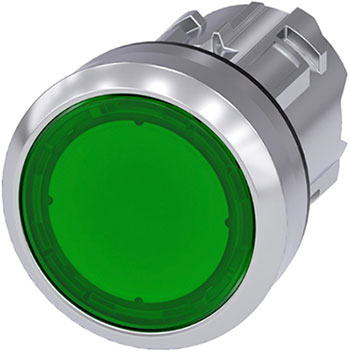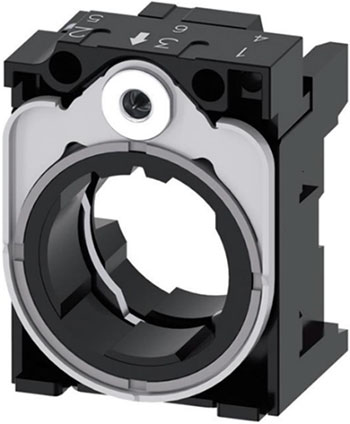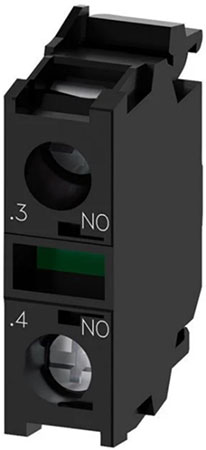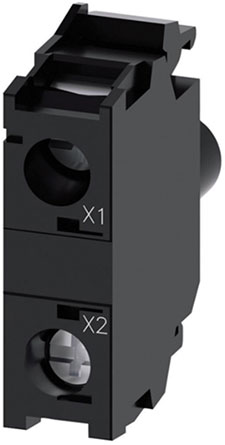Modular Pushbutton System Snaps Together for Flexible Control Panel Designs
When I was a child, my father would often take me to the pharmaceutical plant where he worked. I still remember marveling at the control panels full of lights and buttons that kept everything running.
Decades later, those pushbutton control panels remain ubiquitous. But today’s control stations are rich with innovations that make pushbuttons more sophisticated yet easier to deploy.
With its modular, snap-together architecture, the SIRIUS ACT 3SU1 series from Siemens is a prime example. This series allows designers to easily mix and match buttons, selector switches, indicator lights, and enclosures, thanks to its largely tool-free assembly process.
This convenience is paired with a rugged design that is ready for demanding environments. The 3SU1 modules are available in both metal and high-grade plastic construction, with ingress protection to IP69K and robust NEMA ratings such as NEMA 4. Global certifications, including parts with ATEX and SIL safety certifications, enable use cases such as emergency stop even in hazardous areas.
What’s more, the 3SU1 series supports networks like AS-Interface, IO-Link, and PROFINET in addition to traditional hard wiring. Among other benefits, these networks enable integration with the Siemens Totally Integrated Automation (TIA) Portal, which provides hardware configuration, fault diagnostics, and data management.
Anatomy of a 3SU1 command point
To understand how the system works, consider the elements required for a front-mounted illuminated pushbutton (Figure 1). The core of the system is a holder with a mounting hole that accepts the pushbutton from the front and module slots that accept contacts, LEDs, and other accessories from the rear.
 Figure 1: The basic elements of a front-mounted illuminated pushbutton include the button (A) in front of the control panel (B), a holder for securing the pushbutton behind the control panel (C), contact modules (D), and an LED module (E). (Image source: Siemens)
Figure 1: The basic elements of a front-mounted illuminated pushbutton include the button (A) in front of the control panel (B), a holder for securing the pushbutton behind the control panel (C), contact modules (D), and an LED module (E). (Image source: Siemens)
This modular concept extends to the broader 3SU1 range. For example, the system includes enclosures that can house up to six controls in a single weatherproof unit, labeling systems for custom identification, and protective collars to prevent accidental activation of critical controls.
Example build-out: an illuminated start button
Let’s examine a widely used control element: the start pushbutton. One good option for this control is the 3SU10510AB400AA0 (Figure 2). This illuminated pushbutton features metal construction with a high-gloss ring surrounding a green plastic button.
 Figure 2: The 3SU10510AB400AA0 is an illuminated start pushbutton designed for harsh environments. (Image source: Siemens)
Figure 2: The 3SU10510AB400AA0 is an illuminated start pushbutton designed for harsh environments. (Image source: Siemens)
The actuator’s environmental credentials are impressive. It boasts an IP69K protection rating, meaning it can withstand dust, water jets, and even high-pressure, high-temperature cleaning. It also meets NEMA ratings 1, 2, 3, 3R, 4, 4X, 12, and 13. With an operating temperature range of -25 to 70°C and a mechanical life expectancy of 3 million operations, this component is clearly built for demanding industrial applications.
Mounting the pushbutton with a metal holder
Our selected button integrates with a variety of holders, including the 3SU15500AA100AA0 (Figure 3). This model is constructed of metal and features a twist-resistant design to ensure proper orientation. The rear of the holder comprises three slots to easily accommodate the contact and LED modules required for this application.
 Figure 3: The 3SU15500AA100AA0 is a metal holder with three module slots and a twist-resistant design. (Image source: Siemens)
Figure 3: The 3SU15500AA100AA0 is a metal holder with three module slots and a twist-resistant design. (Image source: Siemens)
Siemens also offers plastic holders, as well as holders with one to four slots to match the complexity of the control function. Modules can even be stacked two deep, enabling sophisticated multi-function control points in a compact footprint.
High-reliability control and illumination with snap-in modules
The 3SU14001AA101BA0 (Figure 4) provides the actual electrical switching function. This normally-open (NO) contact module handles up to 10 amperes (A) and 500 volts AC (VAC). Its silver alloy contacts ensure reliable switching over the product’s electrical life of 10 million cycles. Mounting this contact block into the holder is a simple matter of snapping it into place.
 Figure 4: The 3SU14001AA101BA0 is an NO contact with screw terminals. (Image source: Siemens)
Figure 4: The 3SU14001AA101BA0 is an NO contact with screw terminals. (Image source: Siemens)
The 3SU14011BB401AA0 (Figure 5) completes our start button by providing illumination. This green LED module operates on 24 volts AC (VAC) or DC (VDC) and delivers up to 1,400 millicandelas (mcd) for enhanced visibility even in bright environments. Like the contact module, the LED module snaps into the holder.
 Figure 5: The 3SU14011BB401AA0 module features a green 1,400 mcd LED and screw terminals for a 24 volt supply. (Image source: Siemens)
Figure 5: The 3SU14011BB401AA0 module features a green 1,400 mcd LED and screw terminals for a 24 volt supply. (Image source: Siemens)
Beyond standard pushbuttons, the 3SU1 family includes emergency stop mushroom buttons, key-operated switches, and other specialized parts. Similarly, the range of contacts, lighting, and other accessories is comprehensive.
Conclusion
The Siemens 3SU1 series introduces modern innovation to control panels, a fundamental element in industrial automation. The series’ modular, snap-together design simplifies both specification and installation, while support for networks like PROFINET and AS-Interface connects these traditional controls to today’s industrial automation infrastructure. The control panels that captivated me as a child might look the same, but, under the hood, they’ve clearly evolved!

Have questions or comments? Continue the conversation on TechForum, DigiKey's online community and technical resource.
Visit TechForum










